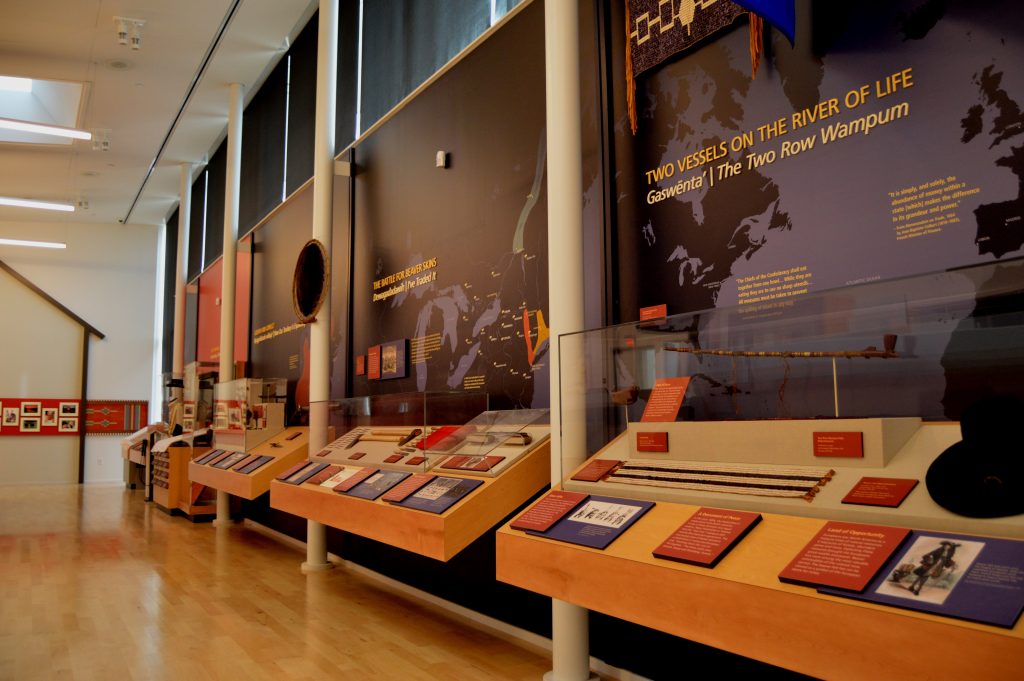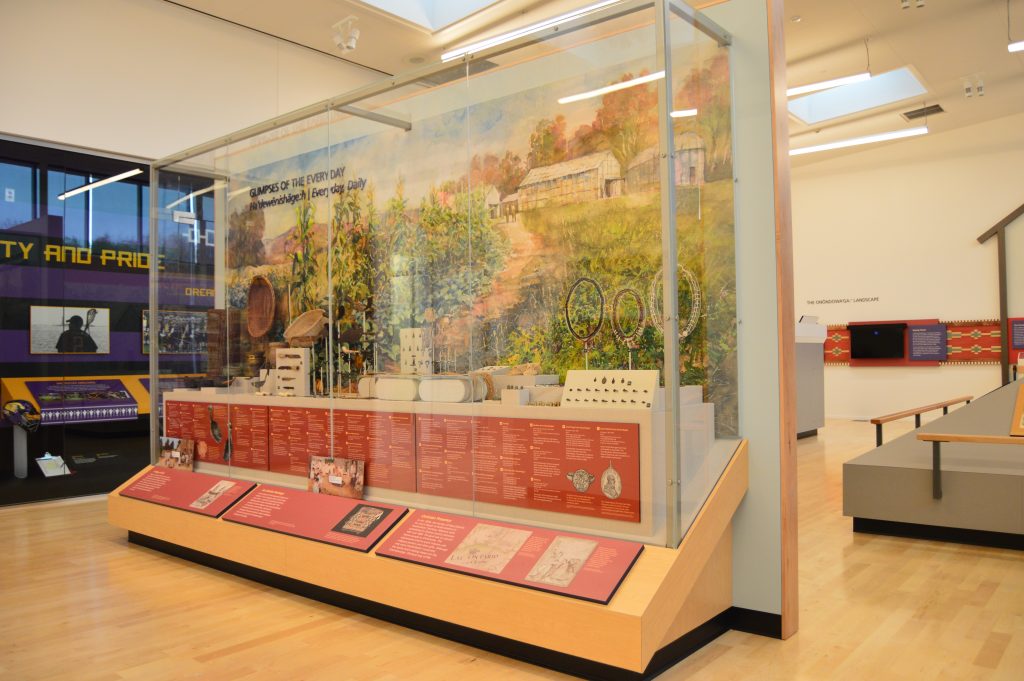from multiple contributors

In GRASAC’s inaugural newsletter on March 1, 2020, Laura Peers updated us about her work of renewing GRASAC’s official institutional relationships with museums, cultural centres, galleries, and archives around the world. This work is resulting in new and renewed connections, some of which are introduced below and others of which will be featured in upcoming newsletters. Please join us in welcoming these individuals and institutions to GRASAC’s network!
For a “global view” of GRASAC’s institutional connects, check out this view of them mapped on Google Earth. This gives a visual sense of the range, number, and extent of institutions which are part of GRASAC (note, however, that this image does not represent a complete, updated, or authoritative list).


Ganondagan State Historic Site – Michael Galban
Sgeno!
My name is Michael Galban and I am Wašiw (Washoe) and Kutzadika’a (Mono Lake Paiute) and am the curator for the Seneca Art & Culture Center at Ganondagan State Historic Site. We are a multi-faceted facility that’s main goal is to present the history, culture and art of the Seneca people to the public. We maintain a large gallery space where we unite oral history with the documentary and archeological record. We prioritize the contemporary presence of Seneca and to a large extent Haudenosaunee people as a vibrant living and thriving culture.
Museum of Archaeology & Anthropology, Cambridge – Dr Jocelyn Dudding and Rachel Hand
The Museum of Archaeology & Anthropology (MAA) was founded in 1884 as part of the University of Cambridge. The current museum has a limited display space in the historic building and currently no Great Lakes material is exhibited, though we have an active loans programme. We care for a small group of c.90 Woodlands and Great Lakes pieces and c.70 photographs. Some of the objects date to the 18th century and came to us via older institutions. Others were collected later by travellers, military men, researchers such as folklorist Mary Alicia Owen, or purchased after 1884 with little documentation. All of MAA’s collections are available on https://collections.maa.cam.ac.uk/ with existing images downloadable via Creative Commons.
We were delighted to welcome a GRASAC delegation to MAA in 2009 and many new attributions and details were added to around 60 objects and photos, most of which are listed on the GRASAC G4 database.
We’re always happy to answer enquiries about these and the other collections we care for and these should be directed to the collections address, feedback@maa.cam.ac.uk or to the relevant Collections Managers, Rachel Hand (objects- rachel.hand@maa.cam.ac.uk) or Dr Jocelyn Dudding (photographs jos.dudding@maa.cam.ac.uk).
National Museum of Denmark – Mille Gabriel and Rikke Ruhe
Mille Gabriel is the senior researcher and curator of the North and South American collections at the National Museum of Denmark. She holds a PhD in Anthropology (2011) and a MA degree in Archaeology (2002). Her research centers on cultural heritage and identity issues with a particular focus on the relationship between museums and communities of origin.
Mille Gabriel is a member of the Danish National Commission for UNESCO (2016 -) and a former board member of ICOM Denmark (2010 – 2017).
Rikke Ruhe is a curator and registrar at The National Museum of Denmark. She holds an MA degree in both Ethnology (2001) and Museology (2007). She works with collections, archives, loans and digital resources.
The Collections at The National Museum of Denmark dates back around 400 years with the former Royal Collections being a small and early backbone of the current and much larger collections. The Ethnographical Collection holds ca. 230,000 items, a substantial part being from Greenland, Canada, Northern Siberia and Alaska, represented by both archaeological finds and items with a more recent history.
Ethnologisches Museum Berlin (Staatliche Museen zu Berlin – Stiftung Preussischer Kulturbesitz) – Monika Zessnik
The Ethnologisches Museum (Ethnological Museum) evolved from the collections of the royal cabinets of art in Berlin and was founded in 1873. Currently the museum is preparing the moving of the exhibitions to the Humboldt Forum, a place for culture and science, for exchange and debate in the center of Berlin, which will host permanent exhibitions from a range of partner institutions.
The North American collections from the east of the US and Canada mainly consist of objects from the late 18th, early 19th century. From the period up to 1850, the collections gathered by Prince zu Wied, Duke Paul Wilhelm of Württemberg and Friedrich Köhler are particularly noteworthy. A collection of painted bison robes dates to before 1850.
Through the work of Franz Boas and Adolf Bastian’s contacts with North American museums and collectors, numerous collections of objects from the prairies and plains and the southwest of America came to Berlin around 1900. The only museum expedition to North America organized by Berlin was undertaken by J. Adrian Jacobsen from 1881-83along the Northwest Coast and Alaska. Nearly 7,000 objects were brought to Berlin as a result of Jacobsen’s travel activities.
Monika Zessnik is curator of the North American Collection in the Ethnologisches Museum. Prior to that, she worked as a curator of education at the Staatliche Museen zu Berlin, head of communication at the Ibero-American Institute and project coordinator at the Haus der Kulturen der Welt in Berlin. Her field research includes topics like religious influences on indigenous socio-economic systems. Currently her work is focusing on the interface between curating and education as well as on transcultural knowledge exchange with different communities and interest groups.
National Museums Scotland – Dr. Ali Clark
Dr Ali Clark is the new Senior Curator for Oceania and the Americas at National Museums Scotland.
Prior to her appointment at National Museums Scotland she was a post-doctoral research associate on the ERC funded project, ‘Pacific Presences: Oceanic Art and European Museums’ (2013-2018) based at the Museum of Archaeology and Anthropology (MAA), Cambridge. She has previously worked on a Getty Funded project (2007-2009) to document photographs from Oceania and the Americas at the British Museum, and an exhibition of contemporary Anishinaabe art at the October Gallery in London.
National Museums Scotland cares for over 12 million objects from around the world. The collections represent applied art and design, Scottish history and archaeology, world cultures, natural sciences and science and technology. The Department of World Cultures cares for over 3000 cultural heritage items from North America.
McCord Museum – Dr. Jonathan Lainey
A member of Huron-Wendat of Wendake, Jonathan Lainey is a historian conducting research on Wendat history and culture, wampum belts and Indigenous heritage in general. One of his main research interests is documenting the stories of specific heritage items, from their early origins when they were still in the hands of their original owners to today as items of museum collections.
He has been the Curator, Indigenous Cultures at the McCord Museum in Montréal since February 2020. Prior to that held the position of Curator, Indigenous Peoples, at the Canadian Museum of History, where he worked on developing the content of the section on recent Indigenous history in the Canadian History Hall that was launched in 2017. Before his time at CMH, he was Archivist, Aboriginal Archives, at Library and Archives Canada for almost 10 years.
The renowned McCord Museum’s Indigenous Cultures collection is composed of over 16,000 archaeological and historic artefacts recounting nearly 12,000 years of history. Moosehair and porcupine embroidered objects, “tourist art” and crafts, weapons, clothing and accessories from the Eastern Woodlands and Great Lakes region are among the oldest and rarest and, worthy of notice, for a museum McCord has the largest number of wampum belts (13) in Canada (which is more than European collections as well).
Peabody Museum of Archaeology and Ethnology, Harvard University – Dr. Diana DiPaolo Loren and Cindy Mackey
Founded in 1866 by philanthropist George Peabody, the Peabody Museum is among the oldest anthropology museums in the world, and still occupies its original nineteenth-century building. The Museum engages in, supports, and promotes the study and appreciation of ancient and contemporary peoples from around the world. The Museum collects, preserves, and interprets cultural and related materials and offers unique opportunities for innovative teaching, research, and enrichment at Harvard and with communities worldwide.
As one of the oldest museums of anthropology, the history of the Peabody Museum is intricately linked to legacies of settler colonialism and imperialism both in the United States and around the globe. The Peabody Museum is committed to addressing this past and shaping future practice by partnering with Indigenous communities towards goals of relationship building, collaborative dialogues, and fostering diverse perspectives on Museum collections and in Museum spaces.
Diana DiPaolo Loren (PhD, SUNY Binghamton) is Senior Curator at the Peabody Museum. Loren is an anthropological archaeologist focusing on the colonial Northeastern United States, particularly issues of the body, health, dress and adornment. She co-directs the Archaeology of Harvard Yard Project, which examines the early multicultural beginnings of Harvard College in the 17th century.
Cindy Mackey is the Associate Registrar for Rights and Reproductions at the Peabody Museum. She handles image and permission requests, works with object photographers and researchers on various imaging projects.
